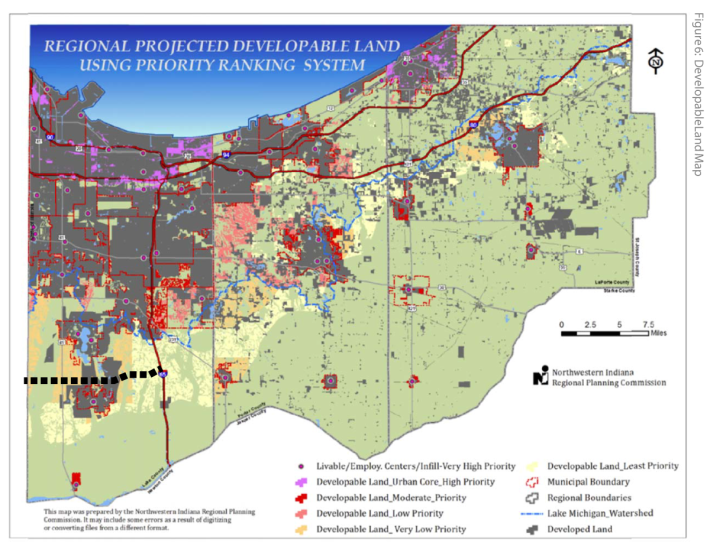
The Illinois Department of Transportation is pushing forward with the risky and unnecessary Illiana Tollway by announcing its "short list" of four finance and construction groups that can build the 35-mile Illinois portion. Streetsblog has reported abundantly from the Illinois perspective -- including a look at IDOT's own analysis showing a net decrease in Illinois jobs as a result of the project. But it's also worth taking a look at how the process -- and the opposition -- have played out in Indiana.
Like IDOT, the Indiana Department of Transportation had to convince the regional planning agency to accept the tollway in its Comprehensive Regional Plan. This plan is very similar to Chicagoland's GO TO 2040. The northwestern Indiana plan "embraces constrained, planned growth, and encourages sustainable development within existing communities whose population centers will be livable and vibrant."
And again like IDOT, InDOT succeeded in getting the plan amended to include Indiana's 12-mile portion of the Illiana Tollway. In December, the amendment was approved by the Northwestern Indiana Regional Planning Commission in a 29-8 vote, a much wider margin than the 11-8 vote at the CMAP MPO Policy Committee.
Opposition to the tollway in Indiana, it seems, was based more on the effect on land use and sprawl than the allocation of taxpayer dollars. Hammond Mayor Thomas McDermott Jr. said the tollway doesn't conform to the regional plan, which "focuses on revitalization of Lake County’s urban core," and that it "would contribute to urban sprawl in the south of Lake County."
NIRPC's staff gauged the impact of the highway on the regional plan's goals and identified only 15 objectives out of 72 in which it would be consistent with the plan [PDF]. A majority of the effects were found to be uncertain because of insufficient data, or because the planning staff couldn't make a determination "until certain events unfold or clearer relationships have been identified."
The NIRPC report had a lot to say about sprawl. In the detailed section on land use and population growth, their analysis found many ways in which the Illiana Tollway does not align with the comprehensive regional plan.
The report notes that land use in northwestern Indiana has followed a pattern of "outward expansion." Newer, cheaper housing draws development in unincorporated areas. The lower initial costs, it says, attracts "people out to the urban fringe and unincorporated areas, and once‐thriving communities are left with vacant lots and a dwindling tax base, which are causing major issues in the inner cities."
The new highway, meanwhile, would run atop greenfield land in undeveloped areas, likely exacerbating these problems. The NIRPC report found the Illiana Tollway will have "uncertain" conformity with the goals of developing around existing infrastructure and building affordable housing.
In essence, the report called for stronger policies and protections to "guarantee proper implementation" of growth strategies, like limiting residential development on farmland. That's the kind of development that can't support transit, and leads to longer driving distances, increased pollution, and high household transportation costs.
There are also concerns that natural resources won't be able to support the sprawl. Julie Roesler, a nurse and member of the Indiana Sierra Club Dunelands group, emailed Streetsblog several months ago to alert us to the conservation perspective in Indiana. "[Building the Illiana] would seem likely to initiate sprawl, and at the very least, would pave over important agricultural and natural areas. Water in the Kankakee watershed is limited and would not be able to support a large increased need if population, industrial, or even agricultural needs grow."
The NIRPC staff report concurs, finding that land near the highway would be classified as a combination of "unsuitable for urban development," "very low priority," and "least priority development" on the basis of conserving natural resources.
Right now, it looks like the one way the expensive Illiana Tollway boondoggle can be avoided is if the state DOTs fail to secure good financing.
Still, the Federal Highway Administration has to approve the Tier 2 Environmental Impact Statement, released today, before IDOT and InDOT can proceed with construction. The 45-day public comment period for the Tier 2 EIS begins today. Stay tuned for a review of the Tier 2 EIS.




